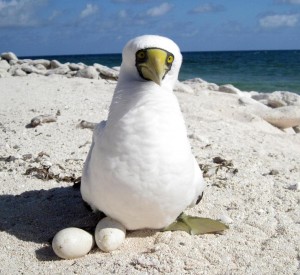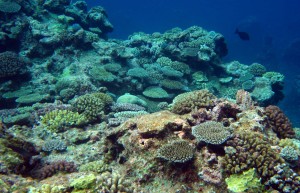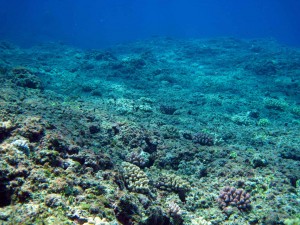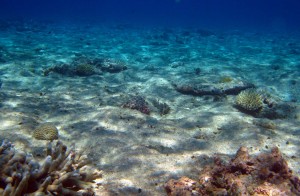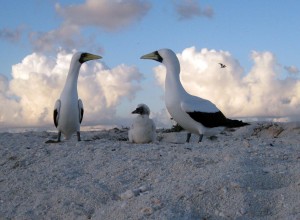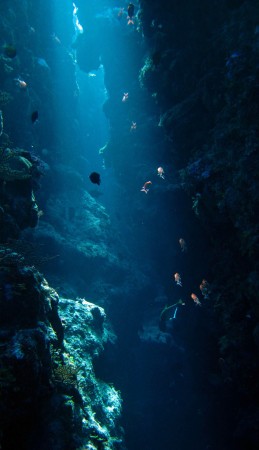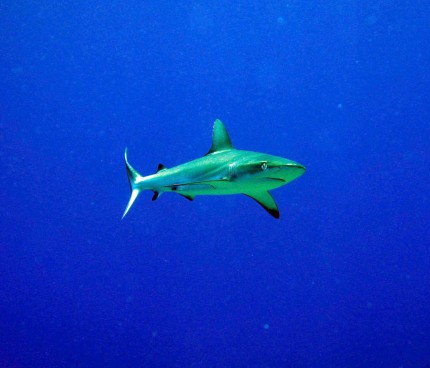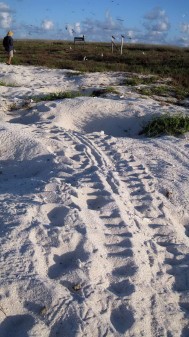The Coral Sea

This article provides a brief review of the Coral Sea, and lists the main body of literature written about this important geographic region. The Coral Sea hosts a high diversity of geomorphic and oceanographic features, giving rise to numerous habitats and ecosystems, from abyssal seafloor over 4,000 m deep to vegetated coral cays above the ocean’s surface. This area hosts important habitats and migration corridors that sustain unique assemblages of organisms. Many of the Coral Sea’s ecosystems and ecological processes remain to be explored and described through scientific research.
The Coral Sea is the body of water east of the Great Barrier Reef, bounded by Papua New Guinea to the north, the Tasman Front to the south, and the west Pacific island chains of the Solomons, Vanuatu and New Caledonia to the east. The Australian portion of the Coral Sea has the Exclusive Economic Zone boundary as its eastern border.
The seabed off eastern Australia was shaped by seafloor spreading and the subsidence of major carbonate platforms along the continental shelf (Davies et al. 1989). The geological structure of the Coral Sea is characterised by abyssal plain to the northeast, a series of plateaux and slopes etched by undersea canyons and separated by deep ocean trenches, and the northern end of a volcanic seamount chain to the south (Keene et al. 2008). In shallower waters, 18 coral reef systems emerge from structural high points on the plateaux or from the tops of seamounts, many with multiple small reefs forming their perimeter. Approximately 49 vegetated and unvegetated cays provide the Coral Sea's only terrestrial habitats. The Coral Sea spans five eco-physical sub-regions, each with unique geomorphic features, ocean currents, drivers of productivity and ecological communities (Brewer et al. 2007).
Three major surface currents dominate the Coral Sea region: The South Equatorial Current, the Hiri Current and the East Australian Current. The westward-flowing South Equatorial Current enters the Coral Sea as a series of jets between the Solomon Islands, Vanuatu and New Caledonia. East of the Great Barrier Reef, the South Equatorial Current bifurcates to form the northern Hiri Current, a slow clockwise gyre in the Gulf of Papua, and the southerly East Australian Current (Ganachaud et al. 2007). The bifurcation point moves seasonally north and south, sending west Pacific water across the north of the continent to feed the Indonesian Throughflow in the Timor Sea in winter (Wyrtki 1960), and strengthening the East Australian Current in summer (Scully-Power 1973). The East Australian Current brings warm, low-nutrient water and tropical species southwards as a series of eddies, and is then pushed eastwards by the Tasman Front off northern New South Wales (Zann 2000). Very little is known about how small-scale circulation patterns affect the Coral Sea’s ecology, but slow eddies have been discovered over some of the plateaux that may retain fauna and promote endemism (Middleton et al. 1994; Brewer et al. 2007).
Only three of the Coral Sea’s 18 reef systems – Coringa-Herald, Lihou Reef and Osprey Reef – have been subject to scientific research. One of the most striking observations has been the high variability in cover or density of live coral and fish between reefs, with very low coral cover and fish density at Coringa-Herald (Ceccarelli et al. 2008), and considerably greater abundance of life at Lihou Reef (Ceccarelli et al. 2009) and Osprey Reef (Andrews et al. 2008; Ayling and Choat 2008). Reef size, the degree of sheltered habitat available, and the isolation of each reef from other reef systems is thought to be the most important driver of the abundance and composition of organisms on these oceanic reefs. Low coral cover seems to be a common feature of small, isolated reefs with a general lack of sheltered habitat. Highly exposed reef crests are cemented with a ridge of crustose coralline algae, and wave-swept reef flats are dominated by low-lying algal turf (Byron et al. 2001; Neil and Jell 2001). More sheltered areas are higher in live coral cover, providing greater habitat complexity and hosting larger abundances of invertebrates and fish (Ceccarelli et al. 2009). Coral, fish and invertebrate populations show key differences from the Great Barrier Reef (Planes et al. 2001; Oxley et al. 2003; Sinclair et al. 2007) and some affinities with the western Pacific and reefs of the Arafura and Timor Seas (Endean 1957; Benzie and Williams 1992; Hooper et al. 1999). Some reefs support high densities of sharks and other predators, and protection in no-take Commonwealth Marine Reserves has led to healthy populations of otherwise exploited species (Ceccarelli et al. 2009).
Coral Sea reefs are subject to a high degree of disturbance, with exposure to a high frequency of tropical cyclones and periods of hot, still weather that can lead to coral bleaching events. One of the marine surveys of Lihou Reef documented a major bleaching event, where 65% of the hard coral cover was bleached (Oxley et al. 2005). There are also records of this event from Osprey Reef, where bleaching was higher in deeper water, possibly because deep-water corals were less adapted to high temperature and UV irradiation (Salih et al. 2006). Recovery of impacted reefs appears variable; the Lihou reef coral community was exhibiting clear signs of early recovery in 2008 (Ceccarelli et al. 2009), while Coringa-Herald, last surveyed in 2007, did not (Ceccarelli et al. 2008). Coral species that are naturally more resistant to bleaching dominated tracts of the recovering reefs. Recently discovered low-light (mesophotic) coral communities at depths of 30-150m on the Osprey Reef slope may provide larvae for the recovery of isolated reefs after major disturbance (Bongaerts et al. 2011).
The islets and cays support terrestrial ecosystems, from simple invertebrate food chains based on carrion and detritus on unvegetated cays (Heatwole 1971), to well-developed communities that include 15% of Australia’s Pisonia grandis forests (Batianoff et al. 2009). The cays provide habitat for nesting and roosting seabirds, many of which are of conservation significance, and nesting endangered green turtles (Harvey et al. 2005; Baker et al. 2008). The Coringa-Herald cays are the best-studied, and host at least 30 species of plants that make up 17 distinct vegetation communities. Approximately 70% of plant species are of wider Melanesian provenance, and are essentially a subset of species found in mainland habitats of similar type and latitude. The number of plant species present at any given time on the Coringa-Herald cays is dependent on immigration, survival and extinction rates. It is likely that most species were dispersed along prevailing currents, such as the east-to-west South Equatorial Current, surface currents driven by the south-easterly trade winds and seasonal monsoon winds, and migratory seabirds (Batianoff et al. 2008).
Keystone species are potentially more important in this harsh environment in their role of promoting or protecting biodiversity. On coral cays, the keystone species of plants are those that are abundant and resilient enough to provide consistent habitat for other species of plants and animals (Batianoff et al. 2010). Among terrestrial invertebrates the Guinea ant, Tetramorium bicarinatum, was found to be a key driver of these communities, acting as a keystone species and indicator of active, above-ground invertebrate populations (Greenslade 2008). The native vegetation of Coral Sea cays has evolved without fire regimes, grazing or common insect predation. As a result, some keystone species such as Pisonia grandis have not developed resistance to mainland pests such as scale insects, and have been subject to dramatic impacts from these pests in the last decade. The infestation of scale insects also led to a shift in community structure in the cays' invertebrate fauna (Smith and Papacek 2004; Batianoff et al. 2008; Greenslade 2008).
Deeper Coral Sea ecosystems are still being explored, but have so far revealed a great diversity of geological formations. In the deep ocean, geomorphic features and substrate composition are the main drivers of ecological communities (Beaman 2010), and recent discoveries include coralline sponges considered ‘living fossils’ (Woerheide and Reitner 1996), diverse cold-water coral communities (Beaman et al. 2009), and high abundances of predatory fish and sharks in the deeper reaches of coral reefs (Sarano and Pichon 1988). Geomorphic features such as canyons, shelf breaks, seamounts and reefs can create patches of high productivity in the waters above them, and therefore attract aggregations of pelagic species. Deep-sea benthic communities may provide important foraging areas for deep-diving cetaceans and fish (Brewer et al. 2007). The Coral Sea’s pelagic realm is frequented by numerous threatened and migratory cetaceans, turtles and sharks, as well as tunas and billfishes important to fisheries and conservation. The pelagic realm of the southern Coral Sea has been the site of in-depth trophic studies, revealing three tiers of consumers that are controlled by large densities of mid-trophic fish and squid (Revill et al. 2009; Griffiths et al. 2010). In the nutrient-poor Coral Sea, aggregations of productivity are highly significant and are likely to affect behaviour, reproduction and migration patterns of species that exploit them (AIMS 2011; Young et al. 2011).
References
AIMS (2011) Deep-sea lanternfish in Coral Sea feeding and spawning frenzy. http://www.aims.gov.au/docs/media/news2011/20110215.html
Andrews Z, Clement A-L, Hill J (2008) Reef Check Australia – GBR Project Report. Reef Check, Townsville
Ayling AM, Choat JH (2008) Abundance patterns of reef sharks and predatory fishes on differently zones reefs in the offshore Townsville region. Report by Sea Research for the Great Barrier Reef Marine Park Authority, Townsville
Baker B, Holdsworth M, Finley L, Double M (2008) Seabird monitoring study at Coringa Herald National Nature Reserve. Report to the Department of the Environment, Water, Heritage and the Arts by Latitude 42 Environmental Consultants Pty Ltd, Hobart
Batianoff GN, Naylor GC, Dillewaard HA (2008) Coringa-Herald National Nature Reserve: Continued assessment of vegetation conditions, ecology and resilience to environmental stressors, including climate change and pests. Report to the Department of the Environment, Water, Heritage and the Arts by the Queensland Herbarium, Brisbane
Batianoff GN, Naylor GC, Dillewaard HA, Neldner VJ (2009) Plant strategies, dispersal and origins of flora at the northern Coral Sea Islands Territory, Australia. Cunninghamia 11:97-106
Batianoff GN, Naylor GC, Olds JA, Fechner NA, Neldner VJ (2010) Climate and vegetation changes at Coringa-Herald National Nature Reserve, Coral Sea Islands, Australia. Pacific Science 64:73-92
Beaman RJ (2010) Biological implications of the geo-diversity in the deep Coral Sea. NPA News 80:5-7
Beaman RJ, Jacobson G, Webster JM, Thomas A (2009) Understanding coldwater coral ecosystems on the Great Barrier Reef margin. Project AINGRA09006 - Report by James Cook University, Townsville
Benzie JAH, Williams ST (1992) Genetic structuire of giant clam (Tridacna maxima) populations from reefs in the Western Coral Sea. Coral Reefs, 11(3): 135-141. Coral Reefs 11:135-141
Bongaerts P., Kline D.I., Hoegh-Guldberg O., Bridge T.C.L., Muir P.R., Wallace C.C. & Beaman R.J. (2011). Mesophotic coral ecosystems on the walls of Coral Sea atolls. Coral Reefs, DOI 10.1007/s00338-011-0725-7.
Brewer DT, Flynn A, Skewes TD, Corfield J, Pearson B, Alawo J, Young JW (2007) Ecosystems of the East Marine Planning Region. Report to Department of Environment and Water Resources. CSIRO, Cleveland
Byron G, Malcolm H, Thompson AA (2001) The benthic communities and associated fish faunal assemblages of North East Cay, Herald Cays, Coral Sea. In: Herald Cays Scientific Study Report. Geography Monograph Series No 6. The Royal Geographic Society of Queensland Inc., Brisbane
Ceccarelli D, Ayling AM, Choat JH, Ayling AL, Williamson DH, Cuff B (2009) Lihou Reef National Nature Reserve Marine Survey – October 2008. Report to the Department of the Environment, Water, Heritage and the Arts by C&R Consulting Pty Ltd., Townsville
Ceccarelli D, Choat JH, Ayling AM, Richards Z, van Herwerden L, Ayling A, Ewels G, Hobbs JP, Cuff B (2008) Coringa-Herald National Nature Reserve Marine Survey – October 2007. Report to the Department of the Environment, Water, Heritage and the Arts by C&R Consulting and James Cook University, Townsville
Davies PJ, Symonds PA, Feary DA, Pigram CJ (1989) The evolution of carbonate platforms of northeast Australia. In: Crevello PD, Wilson JL, Sarg JF, Read JF (eds) Controls on Carbonate Platform and Basin Development. SEPM Special Publications, Tulsa, pp 233-258
Endean R (1957) The biogeography of Queensland’s shallow-water echinoderm fauna (excluding Crindoidea), with a rearrangement of the faunistic provinces of tropical Australia. Australian Journal of Marine and Freshwater Research 8:233-273
Ganachaud A, Kessler W, Wijffels S, Ridgway K, Cai W, Holbrook N, Bowen M, Sutton P, Qiu B, Timmermann A, Roemmich D, Sprintall J, Cravatte S, Gourdeau L, Aung T (2007) Southwest Pacific Ocean Circulation and Climate Experiment (SPICE) - Part I. Scientific Background. International CLIVAR Project Office, CLIVAR Publication Series No. 111, NOAA OAR Special Report, NOAA/OAR/PMEL, Seattle, WA, 37 pp.
Greenslade P (2008) Climate variability, biological control and an insect pest outbreak on Australia’s Coral Sea islets: lessons for invertebrate conservation. Journal of Insect Conservation 12:333-342
Griffiths SP, Young JW, Lansdell MJ, Campbell RA, Hampton J, Hoyle SD, Langley A, Bromhead D, Hinton MG (2010) Ecological effects of longline fishing and climate change on the pelagic ecosystem off eastern Australia. Review of Fish Biology and Fisheries 20:239-272
Harvey T, Townsend S, Kenyon N, Redfern G (2005) Monitoring of nesting sea turtles in the Coringa-Herald National Nature Reserve (1991/92-2003/04 nesting seasons). Report to the Department of the Environment and Heritage by the Indo-Pacific Sea Turtle Conservation Group, Inc., Townsville
Heatwole H (1971) Marine-dependent terrestrial biotic communities on some cays in the Coral Sea. Ecology 52:363-366
Hooper JNA, Kennedy JA, List-Armitage SE, Cook SD, Quinn R (1999) Biodiversity, species composition and distribution of marine sponges in northeast Australia. Memoirs of the Queensland Museum 44:263-274
Keene J, Baker C, Tran M, Potter A (2008) Sedimentology and geomorphology of the East Marine region of Australia. Report to the Department of the Environment, Water, Heritage and the Arts by Geoscience Australia, Canberra
Middleton JH, Coutis P, Griffin DA, Macks A, McTaggart A, Merrifield MA, Nippard GD (1994) Circulation and water mass characteristics of the southern Great Barrier Reef. Australian Journal of Marine and Freshwater Research 45:1-18
Neil D, Jell J (2001) Aspects of the climate and geomorphology of North East Cay, Herald Cays, and its reef: a preliminary report. Geography Monograph series No. 6: Herald Cays Scientific Study Report. The Royal Geographic Society of Queensland:131-141
Oxley WG, Ayling AM, Cheal AJ, Thompson AA (2003) Marine surveys undertaken in the Coringa-Herald National Nature Reserve, March-April 2003. Report produced for CRC Reef for Environment Australia by the Australian Institute of Marine Science, Townsville
Oxley WG, Emslie M, Osborne K, Speare P (2005) An assessment of effects of a coral bleaching event at Lihou Reef National Nature Reserve, October 2004. Report to the Department of the Environment and Heritage by AIMS, Townsville
Planes S, Doherty PJ, Bernardi G (2001) Strong genetic divergence among populations of a marine fish with limited dispersal, Acanthochromis polycanthus, within the Great Barrier Reef and the Coral Sea. Evolution 55:2263-2273
Revill AT, Young JW, Lansdell M (2009) Stable isotopic evidence for trophic groupings and bio-regionalization of predators and their prey in oceanic waters off eastern Australia. Marine Biology 156:1241-1253
Salih A, Cox G, Szymczak R, Coles SL, Baird AH, Dunstan A, Cocco G, Mills J, Larkum A (2006) The role of host-based color and fluorescent pigments in photoprotection and in reducing bleaching stress in corals. 10th International Coral Reef Symposium.
Sarano F, Pichon M (1988) Morphology and ecology of the deep fore reef slope at Osprey Reef (Coral Sea). Proceedings of the 6th International Coral Reef Symposium 2:607-611.
Scully-Power PD (1973) Coral Sea flow budgets in winter. Marine and Freshwater Research 24:203-215 Sinclair B, Briskey L, Aspden W, Pegg G (2007) Genetic diversity of isolated populations of Nautilus pompilius (Mollusca, Cephalopoda) in the Great Barrier Reef and Coral Sea. Review of Fish Biology and Fisheries 17:223-235
Smith D, Papacek D (2004) Report on a visit to the Coringa-Herald National Nature Reserve April 2004 with regards to levels of pulvinaria scale (and its parasitoids and ladybird predators) and hawkmoth on Pisonia grandis. Report to the Department of the Environment and Heritage by the Qld Horticultural Institute and Bugs for Bugs, Queensland
Woerheide G, Reitner J (1996) "Living fossil" sphinctozoan coralline sponge colonies in shallow water caves of the Osprey Reef (Coral Sea) and the Astrolabe Reefs (Fiji Islands). In: Reitner J, Neuweiler F, Gunkel F (eds) Global and Regional Controls on Biogenic Sedimentation. I. Reef Evolution. Research Reports. Goettinger Arb. Geol. Palaeont., Goettingen, pp 145-148
Wyrtki K (1960) The surface circulation in the Coral and Tasman Seas. CSIRO, Melbourne 1 - 45 Young JW, Hobday AJ, Campbell RA, Kloser RJ, Bonham PI, Clementson LA, Lansdell MJ (2011) The biological oceanography of the East Australian Current and surrounding waters in relation to tuna and billfish catches off eastern Australia. Deep-Sea Research II 58:720-733
Zann LP (2000) The eastern Australian region: a dynamic tropical / temperate biotone. Marine Pollution Bulletin 41:188-203





